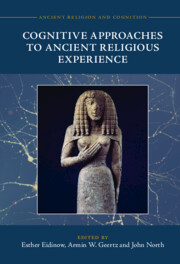Book contents
- Cognitive Approaches to Ancient Religious Experience
- Ancient Religion and Cognition
- Cognitive Approaches to Ancient Religious Experience
- Copyright page
- Contents
- Figures and Tables
- Contributors
- Abbreviations
- Funder Acknowledgement
- Introduction
- Part I Ritual
- Chapter 1 A Cognitive Approach to Ancient Greek Animal Sacrifice
- Chapter 2 To the Netherworld and Back
- Part II Representation
- Part III Gender
- Part IV Materiality
- Part V Texts
- Index
- References
Chapter 2 - To the Netherworld and Back
Cognitive Aspects of the Descent to Trophonius
from Part I - Ritual
Published online by Cambridge University Press: 28 July 2022
- Cognitive Approaches to Ancient Religious Experience
- Ancient Religion and Cognition
- Cognitive Approaches to Ancient Religious Experience
- Copyright page
- Contents
- Figures and Tables
- Contributors
- Abbreviations
- Funder Acknowledgement
- Introduction
- Part I Ritual
- Chapter 1 A Cognitive Approach to Ancient Greek Animal Sacrifice
- Chapter 2 To the Netherworld and Back
- Part II Representation
- Part III Gender
- Part IV Materiality
- Part V Texts
- Index
- References
Summary
We are fortunate to have detailed descriptions of both the ritual and the suppliant’s experience at the sanctuary of Trophonius in Lebadeia that provide an opportunity for a case study juxtaposing ancient evidence with the results of modern research in cognitive science. The paper explores changes in the suppliant’s body and mind, experienced during his stay in Trophonius’ sanctuary.<break/>The main rite was a descent into the artificial subterranean cave of Trophonius, who was believed to appear to the suppliants in person. In the subterranean chamber the inquirer experienced alteration of consciousness, induced by sensory deprivation and comprising vortex and out-of-body experiences as well as hallucinations and the sensation of unmediated communication with supernatural beings. The core experience was preceded by a series of preliminary rites, each of them involving a different cognitive and/or physiological mechanism.<break/>The ritual of descent to Trophonius combined characteristics of a mystery rite, such as secrecy, brush with death, utter distress, obliteration of memory, and personality change, and an oracular consultation, which was based on interpretation of hidden knowledge revealed in the sacred grotto.
- Type
- Chapter
- Information
- Cognitive Approaches to Ancient Religious Experience , pp. 44 - 66Publisher: Cambridge University PressPrint publication year: 2022

